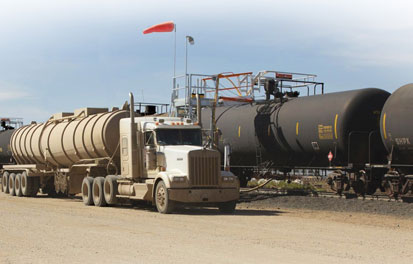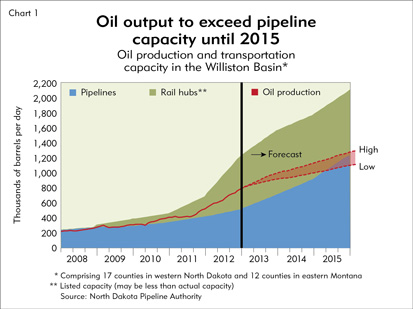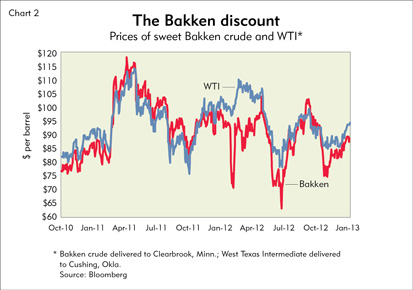Video: fedgazette Writer Phil Davies on energy transportation in the Bakken oil patch
The Quick Take: In recent years, oil production in the Bakken region of western North Dakota and eastern Montana has outstripped the infrastructure needed to move it to refineries across the country. Because of pipeline bottlenecks, Bakken crude oil has often traded at a discount to other types of domestic oil, and natural gas producers also face transportation constraints. Energy transportation firms have invested billions of dollars in new or expanded pipeline and rail infrastructure to relieve bottlenecks and move crude oil and gas efficiently from wellhead to market. Energy transport has also created jobs and increased tax revenues in the region. But matching supply to demand in energy transport will be a challenge due to uncertainty about how high Bakken production will ultimately rise. Producers and transportation firms are trying to gauge future capacity and are experimenting with different transport modes to reduce risk and maximize profit.
Charlie Roehm and his crew were waiting for an oil train at a rail loading facility in Berthold, N.D. The BNSF Railway train from Minot was behind schedule, but everything was in place to begin pouring Bakken crude into 90 identical tanker cars. At 15 cars a day, it would take a week to fill the unit train, whose payload comes from innumerable trucks driving from oil wells to the west, lined up at Berthold to disgorge their loads.
So much oil is being produced in western North Dakota and eastern Montana that it’s turning competitors—railroads and pipelines—into partners in the vast enterprise of transporting that energy. The Berthold rail hub, an on-ramp to BNSF’s nationwide rail network, is owned by Canadian oil transporter Enbridge, one of the largest pipeline companies in North America.
Enbridge built the rail facility last year to help ease a bottleneck on its large, nearby pipeline that carries oil eastward through North Dakota into Minnesota. The roughly 70,000 barrels of oil loaded on each unit train bypass the pipeline, headed to oil terminals and refineries all over the country. “We can only pump out so much,” said Roehm, supervisor of Enbridge’s rail operations. “What we’re doing is optimizing the use of our facilities by bringing in more oil and putting it onto rail instead of the pipeline.”
A second phase at the site will connect pipeline nodes in the heart of the Bakken to the Berthold facility, eliminating the need for producers to truck oil 50 miles or more. Once completed—shipments were slated to begin this spring—the large, hangar-like building will enable Enbridge to offload oil from its main pipeline into tank cars, boosting Berthold’s rail capacity eightfold and freeing up capacity on the pipeline. The current truck-loading facility “is just temporary, to get us going,” Roehm said. “Phase two is the real deal, because that’s where we’re moving a lot of oil.” Enbridge has spent $160 million on the entire facility.
As has been well chronicled (including by the fedgazette), oil and gas production in the Bakken has surged over the past seven years. Getting that product to far-away markets is no less important and similarly complicated, but given much less attention. In recent years, oil production has outraced the infrastructure to move it to refineries across the country, with predictable results.
“Bottlenecks are occurring at all levels,” said Lynn Helms, director of the North Dakota Department of Mineral Resources (DMR). The transport kinks arise at well sites, where there aren’t enough small pipelines to gather oil (and natural gas produced as a byproduct), as well as on big interstate transmission pipelines such as the Enbridge system. Because of tight capacity on long-haul pipelines, Bakken crude has often traded at a lower price than other flavors of domestic oil, trimming producers’ profit margins and tempering their enthusiasm for further oil investment.
Energy firms have responded vigorously to market demand. Oil and gas producers, pipeline operators and railroads have invested billions of dollars in new or expanded infrastructure to relieve bottlenecks and move fossil fuels as quickly and cheaply as possible from wellhead to market.
Everywhere in the region, contractors are laying pipeline, erecting giant storage tanks and building rail hubs like the Berthold facility that are proving a lucrative—but probably temporary—alternative to shipping oil by pipeline.
Ongoing efforts to increase capacity to move energy commodities are crucial to fully developing the Bakken’s energy resources, the engine of the region’s robust economic growth. But matching supply to demand in energy transport will be a challenge as the Bakken continues to break records for energy production.
The market for shipping hydrocarbons is dynamic and fluid; producers and transportation firms are trying to gauge how much capacity is needed and are experimenting with different transport modes to reduce risk and maximize profit. In addition, the path is not completely smooth for energy transportation projects in the region. Obstacles to rapid development include tightened federal environmental rules and rising costs of securing pipeline right of way from landowners.
The pig in the python
Transporting energy within the Bakken region and beyond to markets across the country used to be straightforward. Large pipeline systems carried crude oil and natural gas mostly from western Canada into the United States, and the modest amounts produced in Montana and North Dakota just went along for the ride.
Long-established, major conduits for oil include the Enbridge System, which delivers oil to refineries in the Twin Cities and Chicago via pipeline connections in Minnesota and Wisconsin, and Tesoro Corp.’s High Plains system, the main route for Bakken oil bound for North Dakota’s only refinery in Mandan. For natural gas, two main pipeline systems funnel Canadian gas and coal bed methane from the Powder River basin in Montana and Wyoming toward Midwest population centers, picking up gas from northeastern Montana and western North Dakota on the way (see map below).
Map


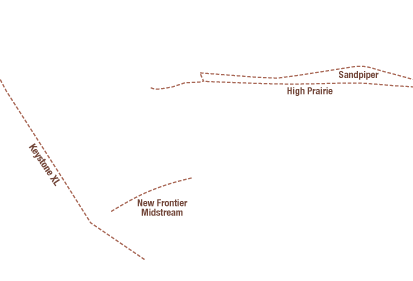
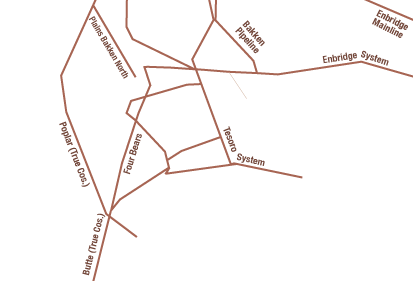
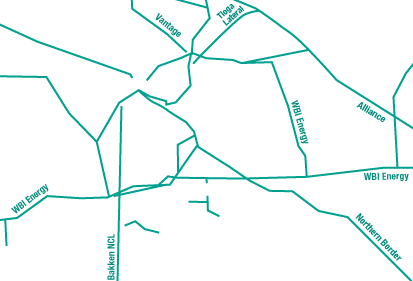





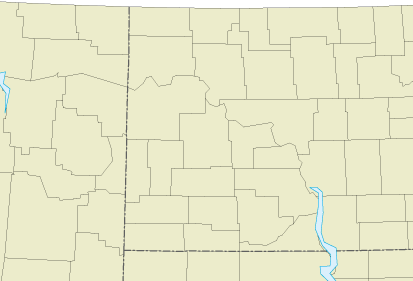
Show:
Pipelines are by far the cheapest and safest way to move oil and the only practicable method of transporting gas. But the capacity of this transportation system began to be tested in the late 2000s, as production of shale oil and associated gas from the Bakken and Three Forks formations soared to new heights after the Great Recession.
North Dakota is now the nation’s second-biggest oil-producing state, after Texas. Statewide oil output surpassed 750,000 barrels of oil per day (bopd) in December, more than twice the production of two years earlier. As oil production has climbed, so has the volume of North Dakota gas bubbling out of the ground, also doubling since 2010.
Today the energy transport python is having trouble swallowing the pig—a circumstance few in the oil and gas industry could have foreseen, said Justin Kringstad, director of the North Dakota Pipeline Authority (NDPA), a state agency established in 2007 to facilitate pipeline development. “We way underestimated the potential for the resource,” he said. “We’re realizing now we need more and more pipeline capacity and infrastructure in place.”
Oil and natural gas—oil’s often overlooked sidekick in the Bakken—present different transport challenges. Natural gas, for example, flows freely on dedicated pipelines carrying gas to utilities and other users in the Twin Cities, Chicago and beyond. But hundreds of miles of smaller pipelines are needed to collect gas from wells, and increased gas processing in the region is driving demand for transport for natural gas liquids (NGLs) derived from gas. (See the article “Dealing with gas” for a separate analysis of natural gas production, processing and transportation.)
Constraints on crude oil transport are more straightforward, and more urgent, because oil is by far the most valuable product of Bakken wells. Long-distance oil pipelines can no longer handle the region’s output. According to data compiled by the NDPA, oil pipeline capacity in the Williston Basin—a broad area of western North Dakota and eastern Montana that includes oil-producing areas outside the core Bakken region—was about 300,000 bopd short of total oil production in the Basin as of last September. Based on two scenarios for drilling activity and well output, the NDPA projects that crude oil production in the Basin will exceed pipeline capacity at least until 2015 (see Chart 1).
Rail—a transportation option up to three times more expensive than shipping by pipeline—has allowed producers to get around pipeline bottlenecks in many areas. But the rail network’s functional capacity is less than Chart 1 implies, due to loading delays at rail hubs, scarce railcars and other constraints.
Because of choked pipelines in the district and elsewhere, Bakken crude has sold for less than oil from other parts of North America in recent years, reducing returns on investment for North Dakota and Montana producers. Together with oil from western Canada, Bakken crude backs up in the middle of the continent, causing a regional supply glut that lowers its price. A benchmark for Bakken oil is the price paid for delivery to Enbridge’s pipeline terminal in Clearbrook, Minn. In early January, Bakken sweet crude was selling for about $5 less per barrel than the West Texas Intermediate (WTI) spot price at Cushing, Okla.—a discount equating to $4 million per day in forgone revenues. For extended periods last year, the Bakken-WTI differential was even greater (see Chart 2).
Because of a paucity of small-diameter gathering pipelines, producers already cope with high costs at the wellhead: In North Dakota, over 70 percent of oil is picked up and taken to a pipeline terminal or rail hub by tank trucks—a cumbersome and expensive method that exacts a heavy toll on rural roads.
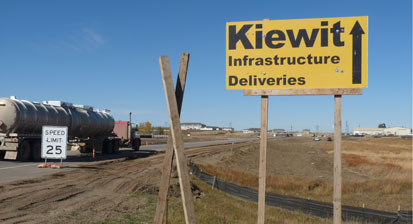
Oil and gas producers and logistics firms have invested heavily in energy transportation infrastructure in the Bakken. Photo by Phil Davies.
Money on the move
Rising demand for energy transport has given pipeline companies, railroads and other market participants ample incentive to invest heavily in the Bakken region—part of a continentwide wave of spending on transportation infrastructure for shale oil and gas. IIR Energy, an energy market research firm, estimates that $10 billion will be spent on crude oil pipeline projects in North America this year—four times the average of the previous seven years.
In the Bakken, pipeline, rail and other infrastructure development has altered the pattern of energy movement in the region and gone a long way toward alleviating bottlenecks. Continued investment may eliminate the Bakken crude discount altogether in the not too distant future.
Little in the way of public data exist on energy transportation investment in the Bakken region—mostly privately held pipeline companies and other “midstream” firms that ship or process energy products closely guard their financials. But a partial list of recently built and proposed energy transport projects gives an indication of the scale of investment (see table).
Getting in the flow
Major pipeline projects in the Bakken region
Pipelines operating or under construction*
| Project name, owner/developer, and description | Capacity | Cost | In Service |
|---|---|---|---|
|
Bakken Pipeline (show details) |
145,000 bopd | $180 million | 1st quarter 2013 |
|
Four Bears Pipeline (show details) |
110,000 bopd |
Undisclosed | 2011 |
|
Plains Bakken North Pipeline (show details) |
50,000 bopd | $60 million | Mid-2013 |
|
Bakken NGL Pipeline (show details) |
60,000 bopd | $500 million | 1st quarter 2013 |
|
BakkenLink Pipeline (show details) |
65,000 bopd | $127 million | 4th quarter 2013 |
|
Tioga Lateral Pipeline (show details) |
126 MMcfd | $168 million | 2nd quarter 2013 |
|
Vantage Pipeline (show details) |
40,000-60,000 bopd | $240 million | 3rd quarter 2013 |
*Projects undertaken since 2011.
Sources: North Dakota Pipeline Authority; oil and gas industry reports
Proposed pipelines
| Project name, owner/developer, and description | Capacity | Cost | In Service |
|---|---|---|---|
|
Sandpiper Pipeline (show details) |
225,000-375,000 bopd | $2.5 billion | 2015 |
|
High Prairie Pipeline (show details) |
150,000 bopd | Undisclosed | 4th quarter 2013 |
|
Crude oil and NGL pipelines from Dickinson, N.D., to Baker, Mont. (show details) |
Undisclosed | Undisclosed | 4th quarter 2013 |
|
Keystone XL Pipeline (show details) |
100,000 bopd of Bakken crude; total capacity of 830,000 bopd | $5.3 billion | 2015 |
Sources: North Dakota Pipeline Authority; oil and gas industry reports
Major rail facilities operating or under construction*
| Project name, owner/developer, and description | Capacity | Cost | In Service |
|---|---|---|---|
|
Bakken Oil Express near Dickinson, N.D. (show details) |
100,000 bopd | Undisclosed | 2011 |
|
Manitou rail facility, Ross, N.D. (show details) |
65,000 bopd oil; 8,500 NGLs |
$40 million | 2011 |
|
COLT Hub, Epping, N.D. (show details) |
120,000 bopd | Undisclosed | 2nd quarter 2012 |
|
Van Hook Crude Terminal near New Town, N.D. (show details) |
35,000 bopd | Undisclosed | 1st quarter 2012 |
|
Musket crude oil rail terminal, Dore, N.D. (show details) |
60,000 bopd | Undisclosed | 2nd quarter 2012 |
|
Savage Bakken Petroleum Services Hub, Trenton, N.D. (show details) |
90,000 bopd | Undisclosed | 3rd quarter 2012 |
|
Hess rail yard Tioga, N.D. (show details) |
60,000 bopd | $50 million | 1st quarter 2012 |
|
BakkenLink rail hub, Fryburg, N.D. (show details) |
65,000 bopd | $40 million | 4th quarter 2012 |
|
Enbridge rail hub, Berthold, N.D. (show details) |
80,000 bopd | $160 million (both sites) | 1st quarter 2013 |
|
Global Basin Transload, Beulah, N.D. (show details) |
60,000 bopd | Undisclosed | First half 2012 |
Table lists most hubs built since 2011; information unavailable for some facilities.
Sources: North Dakota Pipeline Authority; railroad and energy industry reports
Outlays by some of the biggest market players run to hundreds of millions of dollars annually. Enbridge, for example, has spent $1.2 billion to construct or expand pipeline and rail facilities (including the Berthold hub) in North Dakota since the oil boom began in the state.
Upfront infrastructure costs are steep; laying a 12-inch diameter transmission pipeline costs roughly $800,000 per mile, Kringstad said. But raising capital doesn’t seem to be an obstacle for energy transportation enterprises. Institutions, venture capitalists, angels and large banks are eager to fund projects in the Bakken, said Rodney Wren, president of New Frontier Midstream, a Texas firm that is developing gas-processing plants and oil and gas pipelines in North Dakota and Montana.
“We have some financial institutions [and] some very wealthy individuals in the billion-dollar range who want to [invest in the company],” he said. “It’s amazing how much money is out there that wants to get into greenfield projects.”
Rather than raising capital, the challenge for many midstream operators is putting together projects that make financial and logistic sense, and securing buy-in from producers who are often reluctant to commit to a particular transport mode or route. Usually ground isn’t broken for new pipelines, rail hubs, storage tanks or other transportation facilities until oil or gas producers have agreed to purchase capacity at a predetermined rate. For pipelines, tariffs must be approved by state utility regulators or, for interstate pipelines, the Federal Energy Regulatory Commission.
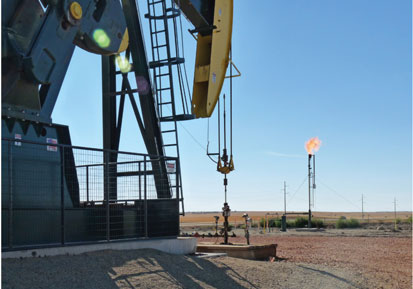
Natural gas, a byproduct of oil production in the Bakken, presents its own transport challenges. Photo by Phil Davies.
Laying pipe
Much of the investment in energy transportation has focused on expanding the capacity of the pipeline network. Drive a few miles in any direction in the oil patch, and you come across a pipeline trench being dug or disturbed soil indicating the route of a recently laid line. If all projects under construction or proposed go into service, the capacity of oil transmission pipelines in the region will more than double to about 1.2 million bopd by 2015.
One of the most ambitious oil pipeline projects is Enbridge’s Bakken Expansion—a $700 million effort to increase capacity on the company’s main route spanning North Dakota, which connects in Clearbrook with an even bigger line originating in Canada. The three-year program includes the Bakken Pipeline, a reconstruction and reversal of an existing line that previously carried Canadian crude south to Berthold. The 145,000 bopd line is slated to become fully operational this spring, bypassing a bottleneck in North Dakota by pumping oil into Manitoba and then south on the mainline through Clearbrook.
Once online, the Bakken Pipeline and other projects will increase Enbridge’s takeaway pipeline capacity for Bakken oil to about 400,000 bopd—more than five times the capacity of the North Dakota system in the mid-1990s. Enbridge has proposed another major pipeline that would add 225,000 bopd to the river of Bakken oil flowing east to refineries in the Midwest and the South. The $2.5 billion Sandpiper Pipeline would stretch over 600 miles from Tioga, N.D., to Superior, Wis.
The True Companies of Casper, Wyo., a family-owned group of firms that operates four crude pipelines in the Bakken region, also is intent on expanding its capacity to meet rising demand for oil transport. Vice President Tad True says that revenues from the company’s Bakken operations have roughly quintupled since 2005 as it has acquired pipelines and built new ones to extend and strengthen its network.
Demand from crude producers in central McKenzie and Dunn counties in North Dakota prompted the construction in 2011 of the Four Bears Pipeline, which snakes 77 miles from New Town., N.D., to Baker, Mont., a major transshipment point for oil and gas. “Before production in that area even started to come online, they were calling us and saying, ‘Hey, you guys really need to consider building in this direction,’” True said.
The most famous pipeline in the Bakken is one that is yet to be built—the Keystone XL Pipeline, a 1,180-mile route from Canada to Nebraska proposed by TransCanada Corp. The controversial project would provide a handy on-ramp for 100,000 bopd of oil from Montana and North Dakota producers—if the U.S. State Department approves it. Environmental groups have objected to the transport of much larger volumes of heavy Canadian crude derived from tar sands because the extraction process consumes more energy and releases more greenhouse gases than other types of oil production.
Midstream companies also are busy laying hundreds of miles of gathering pipelines for oil, gas and drilling wastewater (which by law must be hauled to disposal wells). Last fall, Saddle Butte Pipeline of Durango, Colo., was building an oil- and gas-gathering system on the Fort Berthold Indian Reservation near New Town, and a Denver-based oil company formed a $180 million venture to construct oil-, gas- and water-gathering systems near Alexander, N.D.
All aboard the oil train
Many Bakken oil producers and shippers aren’t waiting for pipelines to be built to carry their crude to market. They’ve turned to trains (“pipelines on wheels”) to transport oil long distances, even though shipping by rail costs about $10 to $15 per barrel, depending on the destination, compared with about $5 per barrel via pipeline. The NDPA estimates that the percentage of Williston Basin oil transported by rail went from 6 percent in 2010 to 60 percent last year—over 450,000 bopd.
Trains have become a popular alternative to pipelines chiefly because they allow producers to sell Bakken crude at higher prices than the benchmark prices posted at pipeline hubs such as Clearbrook and Guernsey, Wyo. To get around pipeline chokepoints, producers started trucking their oil to train depots and in the process discovered that coastal refineries accustomed to buying high-priced imported “sweet” crude (which is easier to refine) would pay a premium for similar crude from the Bakken.
“Even with the higher transportation cost, it’s cheaper than buying at the Brent benchmark price,” said John Duff, an oil analyst with the U.S. Energy Information Administration, referring to the leading global price marker for crude oil.
What’s more, the iron horse offers Bakken producers more buyer options, delivering oil to refineries in Texas, Louisiana, New York, Pennsylvania and other areas not easily reached via pipeline. Last fall, Tesoro began shipping 30,000 bopd of Bakken crude by rail to a refinery in Washington state, and in February Delta Airlines received its first rail shipment of North Dakota crude at a refinery it owns near Philadelphia.
Rail hubs can be developed more quickly than pipelines, which must contend with harsh winters—frozen ground hinders trench digging—and a permitting process that can stretch out almost a year. Under the Obama administration, pipelines that cross federal lands are subject to heightened environmental review. (However, with the exception of Keystone XL, no new pipeline or rail facility in the region has been halted or delayed on environmental grounds.)
Over the past two years, about a dozen rail facilities dedicated to oil transport have been constructed in the Bakken, increasing rail hub listed capacity to 730,000 bopd, according to the NDPA. Pipeline operators as well as logistics firms specializing in energy transport are involved in many of the rail hubs.
The Bakken Oil Express, a rail hub located on a BNSF line west of Dickinson, dispatched its first oil train in the fall of 2011. Its anchor shipper is Eighty-Eight Oil, a subsidiary of the True Companies, which delivers oil to the hub via its Belle Fourche Pipeline. Other customers truck in oil from wells scattered all over Stark County. At startup, the facility could transfer up to 100,000 bopd into railcars; its owner, a Kansas-based logistics firm, was planning to build additional track, loading racks and pipeline connections to more than double capacity.
Other oil rail hubs in the Bakken include Enbridge’s newly expanded hub, which will allow Roehm’s team to load one 100-car unit train per day and send it down the line to markets served by BNSF and other connecting railroads, and a large crude oil terminal near Williston, N.D., owned by Inergy Midstream of Kansas City, Mo.
Railroads have made their own investments in tracks, tank cars, sidings and other facilities to support oil transport. BNSF, the biggest railway mover of domestic crude, spent $197 million for North Dakota and Montana infrastructure improvements in 2012 to increase its capacity to haul Bakken crude to about 1 million bopd.
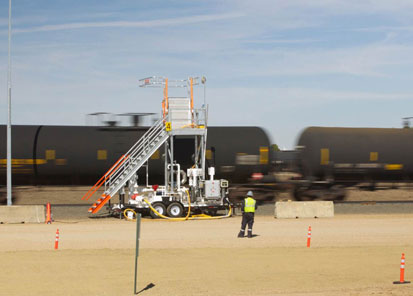
To get around oil pipeline bottlenecks, many Bakken producers turned to the iron horse to deliver oil to distant markets. Photo courtesy of Enbridge.
Widening bottlenecks
All this rail development has dramatically increased crude transportation capacity in the Williston Basin, and producers are reaping the benefits. Sufficient quantities of Bakken crude are moving to the coasts by rail to push up the benchmark price of oil from the region. As midcontinent oil inventories have fallen, the Bakken discount to WTI has shrunk and at times disappeared (see Chart 2).
Rail transport of crude has increased so much that some transmission pipelines in the region are no longer full. True said that oil piped to the Bakken Oil Express hub has “taken away from our long-haul barrels” traveling south on True Cos.’ Butte Pipeline into Wyoming. “Rail is playing a very, very large role in oil transportation,” he said, “and you could argue that there’s not a lot of pipeline bottlenecks anymore because rail has taken so much volume away.”
The rise of rail has also rendered some proposed pipelines superfluous. Last November, Oneok Partners, an Oklahoma-based developer of energy infrastructure, canceled plans to build a $1.8 billion crude oil pipeline from Stanley, N.D., to Cushing because many producers opted to ship by rail instead.
Whether rail has busted oil transportation bottlenecks in the Bakken—and if so, for how long—is difficult to know. One issue complicating infrastructure planning is uncertainty about how much capacity for moving oil and gas will be needed two, five or 10 years from now. The NDPA’s crude oil production forecasts for 2023 range from 1.4 million to 1.7 million bopd, depending on how productive Bakken oilfields prove over time.But those are just estimates, taken with a grain of salt by producers and transportation providers contemplating long-term investments.
“Trying to get a grasp on where we think we’re going to land—what our production numbers are going to be—is absolutely critical as we build out this infrastructure,” said Ron Ness, president of the North Dakota Petroleum Council, a trade association for the state’s oil and gas industry.
The dynamics of energy markets also affect the use of existing capacity and the pace of additional infrastructure development. Preferred routes and transport modes for energy can change weekly as producers and midstream firms grapple with real-time network demand and fluctuating oil and gas prices, and react to decisions by other market players. Last winter, New Frontier Midstream was forced to reroute a proposed $70 million crude oil pipeline from southern Bakken oilfields to the Baker hub because the original line was intended to connect to Oneok’s canceled oil pipeline.
The role of rail in that cancellation is a sign that in the near term oil trains will compete with pipelines and, in some instances, displace them as shippers take advantage of high crude prices on the Gulf and Atlantic coasts. “I think there’s going to be a big tug of war between rail markets and pipeline markets,” True said.
However, most industry sources anticipate pipelines regaining their predominance in oil transport within a few years. New pipelines moving oil out of the Bakken and from Cushing to the Gulf Coast are expected to end the midcontinent oil glut by 2014, permanently shrinking or even eliminating the long-standing differential between Bakken crude and WTI prices. Without a sizable Bakken discount, “the economic incentive disappears” to pay high rail rates to the coasts, Duff said, because producers can earn equal or greater profits by piping oil to Midwest refineries at lower rates.
But maintaining the pace of recent capacity gains may be difficult, especially for pipelines. In addition to winter weather and permitting delays, pipeline developers lately have had to deal with private landowners who either refuse to grant right of way for projects or demand high easement fees. One-time easement fees have risen four- or fivefold over the past three years, said Helms of the North Dakota DMR. “Landowners are tired of being approached over and over and over again. They’ve become more resistant, and it’s become significantly more expensive to acquire that right of way.”
For all these uncertainties, the short history of oil and gas development in the Bakken suggests that producers and other stakeholders in the industry will manage to work the kinks out of the energy transportation system. The region’s mineral riches are simply too great for solutions not to be found.
Said Kringstad of the NDPA: “The industry and the state and all the landowners and the people living and working out there all have the same goal; we want to have a safe and efficient transportation system in place.”



